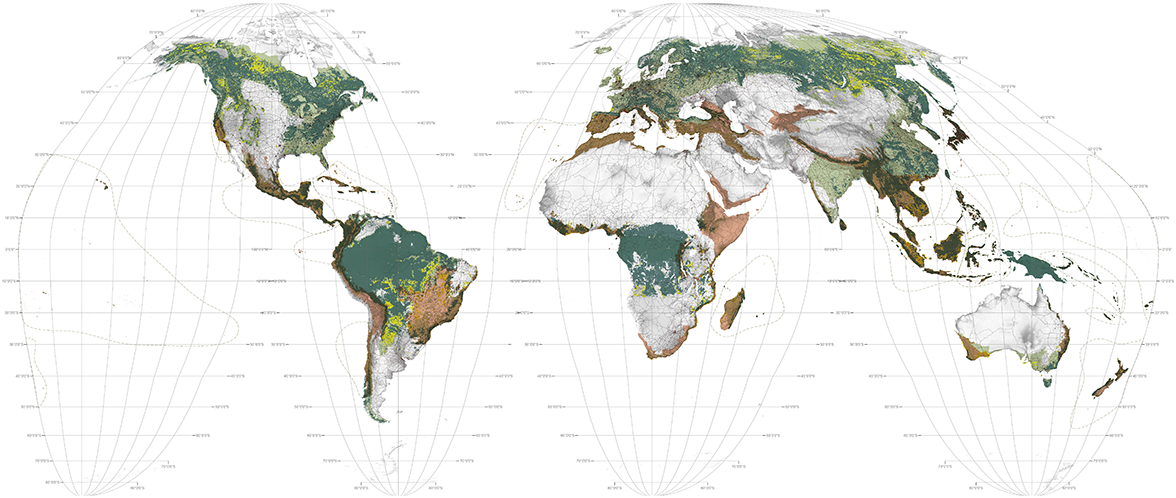Wherever humans have settled, forests have had to make way. The 'Foris', literally meaning that which is 'outside' has been variously revered, feared and felled, in some cases many times over. Throughout history, forests have provided the wood with which we have cooked our food, sterilized our water, built our structures and kept ourselves warm. According to the United Nations Food and Agriculture Organization (FAO) 2014 State of the World's Forests at least 1.2 billion people are dependent on forests for their livelihood. 1 840 million people collect firewood from forests and woodlands each day.
In 1990 the world had 4,128 million hectares of forest; by 2015 this area has decreased to 3,999 million hectares. According to the 2015 Soil Atlas, around 13 million hectares of forest are cleared every year and of the world's primary forests around 40 million hectares have disappeared since 2000. 2 In total 17% of the world's forests are within legally protected areas. 93% of the world's forests are naturally occurring; the remaining 7% is planted. Importantly, around half of the world's lumber supply now comes from these plantations. 3 Naturally occurring forests are in decline, planted forests are increasing. Though not always the case, forested lands are generally increasing in rich countries and decreasing in poor countries.
In 2015, about 30% of the world's forest was designated as production forest, 26% was designated as multiple-use. Multiple-use forest provides varying combinations of industry, recreation and water and wildlife management. 'Primary forests', namely forests designated for biodiversity, constitute 13% of the world's forest. These in part overlap with forests dedicated primarily to the protection of soil and water which constitute 25% of the global total. Half of these primary forests are in the tropics where, according to the United Nations Food and Agriculture Organization (FAO) (2015) Global Forest Resources Assessment between 1990 and 2015 "by far" the most deforestation has occurred. 4
Deforestation is primarily the result of logging and land clearance for agriculture and infrastructure but it also occurs as a direct result of urban sprawl. As documented in this atlas there are 383 cities in the hotspots whose 2030 growth forecasts indicate immanent conflict with high value biodiversity.
The most deforestation between 1990 and 2015 has occurred in Brazil, Indonesia, Myanmar, Nigeria and Tanzania. The greatest forest increases (it takes roughly 100 years for a forest to grow back) have taken place in China, Australia, Chile, USA, and the Philippines. It should be noted here that definitions of what constitutes forest cover vary between nations and between organizations, but generally the minimum requirement is 10% tree cover in landscapes where trees can reach five meters in height. A landscape with a mere 10% tree cover and little understory vegetation is not what most people visualize when they think 'forest'.
1 Food and Agriculture Organization of the United Nations, "State of the World's Forests: Enhancing the socioeconomic benefits from forests," (Rome: 2014), 12. Available at http://www.fao.org/3/a-i3710e.pdf.
2 Christine Chemnitz & Jes Weigelt (eds), The Soil Atlas 2015 (Berlin & Potsdam: Heinrich Böil Foundation & Institute for Advanced Sustainability Studies, 2015), 15. Available at http://globalsoilweek.org/wp-content/uploads/2014/12/soilatlas2015_web_141221.pdf.
3 Food and Agriculture Organization of the United Nations, "Global Forest Resources Assessment 2015" (Rome). Available at Food and Agriculture Organization of the United Nations, “Global Forest Resources Assessment 2015” (Rome). Available at http://www.uncclearn.org/sites/default/files/inventory/a-i4793e.pdf..
4 ibid
1. Forest cover, Forest loss
Source: Hansen/UMD/Google/USGS/NASA
M. C. Hansen, et al., "High-Resolution Global Maps of 21st-Century Forest Cover Change," Science 342, no. 6160 (2013): 850-853. Data available at http://earthenginepartners.appspot.com/science-2013-global-forest (accessed August 2, 2015). Data made available under the Creative Commons Attribution 4.0 International License: https://creativecommons.org/licenses/by/4.0/legalcode.
2. Forest Biomes
D. M. Olson, et al., "Terrestrial ecoregions of the world: a new map of life on Earth," Bioscience 51, no. 11 (2001): 933-938. Available at http://www.worldwildlife.org/publications/terrestrial-ecoregions-of-the-world.
3. Hotspots
Critical Ecosystem Partnership Fund, "The Biodiversity Hotspots," http://www.cepf.net/resources/hotspots/pages/default.aspx (accessed July 1, 2014). Data made available under the Creative Commons BY-SA 4.0 License: https://creativecommons.org/licenses/by-sa/4.0/legalcode.
